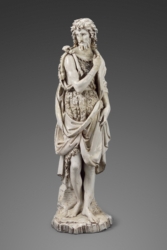A new ‘St. John the Baptist’ in Boston
BOSTON--The three great sculptors of the Italian Renaissance, by common consent, were Donatello, Michelangelo, and the Flemish-born master Giambologna (the last best known for his statue of “Mercury” that became the telephone company’s symbol). The fourth sculptor-genius was Leonardo da Vinci, but sadly, his large-scale bronze statues fell victim to the wars of his era, when the need to forge cannonry overtook the desire for monuments.
A statue of “St. John the Baptist” on display at the Boston Museum of Fine Arts Jan. 24-July 8 may provide insights into the lost sculpture of the enigmatic da Vinci. The statue, two-thirds of life size and fashioned in white glazed terracotta, has been rescued from neglect and prior bad restorations.
Marietta Cambareri, the curator who found it in a storeroom corner, attributed this graceful effigy to Gianfrancesco Rustici, a major Tuscan sculptor of noble birth who shared a house with da Vinci in Florence and was influenced by him. She says, “I feel strongly that it was meant to go inside a church, baptistery, or oratory (of a confraternity). It is not an object for a domestic setting, unless it was made for an important family chapel.”
Rustici modeled the monumental bronze group of “St. John the Baptist Preaching” (1506-11) flanked by a Pharisee and a Levite, that stands over a portal of the Baptistery of Florence. Scholars regard it as a clue to what Leonardo’s own statues looked like. Like da Vinci, Rustici worked in clay rather than marble, and these bronze statues would have been cast from the clay models.
Finding the terracotta St. John was a “eureka” event that inspired the special exhibit at the Boston Museum of Fine Arts, titled “Donatello to Giambologna,” displaying Renaissance sculptures from the museum’s collection (many retrieved from storage and restored for the occasion), plus a handful borrowed from private collections and the nearby Gardner Museum.
Italian Renaissance artists found that the beautiful body could be a means of expressing the beautiful soul. Christian humanism in the arts traces straight back to St. Francis of Assisi, who embraced Christ’s humanity in its corporeal as well as spiritual nature. Franciscanism led artists to take a fresh look at classical antiquity in order to develop a new Christian artistic language, and from there, came the abundant statuary in Catholic churches that started in the Renaissance and continues to the present.
The glazed terracotta used for the “St. John” was invented by Luca Della Robbia, a Florentine sculptor of the early 1400s. Della Robbia’s secretive technique utilized colorful glazes (white, blue, green and yellow) to make terracotta tougher as well as more attractive. (Lots of Della Robbia pieces, some exquisite, are in the Boston show.)
The St. John statue might have stood by an altar. The priest speaks the Baptist’s words, “Behold the Lamb of God, who takes away the sins of the world,” before Communion in every Mass. Rustici’s bronze statue outside the Florentine Baptistery portrays John at the moment he spoke those words, pointing skyward with a declamatory upraised index finger.
The Boston “St. John,” instead, makes a subtler gesture, perhaps evoking his state of mind a moment earlier, as the camel skin-clad prophet gently turns and recognition of the Savior dawns on his sensitively modeled face.



















